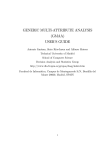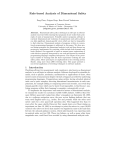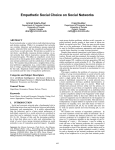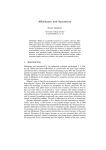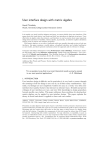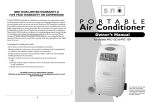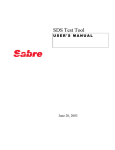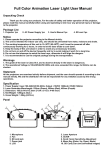Download Modecom MC-105USB User manual
Transcript
U S B U s e r 2 . 0 A d a p t e r I E E E MODE COM WIRELESS NETWORK USB ADAPTER M 8 0 2 . 1 MC-105USB a 1 b / g n W ir u e le s a s l Table of Contents 1 Introduction......................................................................................................................................................................................3 1.1 Product Overview ......................................................................................................................................................................4 1.2 Main Feature of 802.11b/g USB 2.0 Adapter ....................................................................................................................4 1.3 System Requirements ..............................................................................................................................................................4 2 Wireless Network Concepts .......................................................................................................................................................5 2.1 Wireless LAN Network Modes ...............................................................................................................................................5 2.2 Planning Your New Wireless Network ................................................................................................................................7 3 Installation Instructions..............................................................................................................................................................9 4 Utility Configurations................................................................................................................................................................ 11 4.1 Configuration for Windows 98 SE / ME / 2000 .............................................................................................................. 11 4.2 The WLAN Management Utility (Windows 98 SE / ME / 2000) ............................................................................... 12 4.3 Configuration for Windows XP ........................................................................................................................................... 15 5 Uninstall .......................................................................................................................................................................................... 17 5.1 Uninstall Driver and Utility .................................................................................................................................................. 17 Appendix A ........................................................................................................................................................................................ 18 Glossary ............................................................................................................................................................................................. 18 2 www.modecom.eu MODE COM WIRELESS NETWORK USB ADAPTER MC-105USB User Manual 1. Introduction Thank you for your selection of Mode Com Wireless Network USB Adapter MC-105USB. Mode Com places a high value on quality of its products to not only match, but also surpass customers’ requirements. Our clients are well acquainted with high quality, advanced technology, reliability and functionality of our products. To facilitate the use of the device please take a few moments to read the instruction manual thoroughly. Congratulations on your decision to use wireless networking. The 802.11b/g Wireless LAN Card Mode Com MC-105USB is a high performance, IEEE Standard 802.11b/g compatible, wireless networking card that installs into your PC’s slot to support wireless LAN communications at speeds up to 54Mbps with other PC’s located hundreds of feet apart. Figure 1 Typical Wireless LAN Network The 802.11b/g Wireless LAN Card allows reliable, secure and untethered access to your data providing you with exciting new ways to adapt to your lifestyle and needs. Without the limitations of wires, true mobility and data access is seamless in your office or home office. Data access from work, streaming audio MP3’s from a notebook to a stereo, downloading Internet content wirelessly from a broadband connection, watching TV on a notebook, are all possibilities with the Mode Com MC-105USB 802.11b/g Wireless LAN Card. For You we create products unique in every aspect… Choose better future – choose Mode Com! Copyright©2006 Mode Com Ltd. All rights reserved. The Mode Com logo is registered trademark of Mode Com Ltd. 3 1.1 Product Overview The Mode Com MC-105USB 802.11b/g Wireless LAN Card gives you the freedom of secure high-speed communications with other PCs without the need for interconnecting wires. You can even connect in to other LAN infrastructures such as your company’s internal Ethernet LAN or your own home network. The antenna and design of the Wireless LAN Card gives you unmatched sensitivity which means your system will remain connected to other wireless PCs at high speeds for longer distances. The Wireless LAN Card operates according to the IEEE 802.11b/g Wireless LAN specification, for wireless data communications at speeds up to 54Mbps (Megabits per second). IEEE 802.11b/g operates on frequencies in the 2.4GHz range using OFDM (Orthogonal Frequency Division Multiplexing) technology. Backed by international standards and the IEEE organization, IT departments and end-users alike benefit from the reliability and interoperability of products based on these standards. From an investment point of view, it makes good business sense investing in technology that will be support worldwide for many years to come (unlike technologies not backed by international communications standards). Whether you are running a company or a home office, the Wireless LAN Card reduces, or eliminates in some cases, the need to setup wired LAN networks in the office or home office, eliminating costs associated with wiring rooms and buildings. 1.2 Main Feature of Mode Com MC-105USB 802.11b/g USB 2.0 Adapter • Up to 54Mbps data transfer rates for high-speed access to data • Compatible with 802.11g Wi-Fi CERTIFIED equipment (2.4GHz operating range) • Plug-and-play with Microsoft Windows operating systems • Secure data access, up to 128-bit WEP encryption protection • Backward Complain with 802.11b. • Support both Ad Hoc Mode and Infrastructure Mode Access. 1.3 System Requirements • PC with Windows 98 SE, Windows 2000, Windows ME, or Windows XP Operating Systems • An available USB port • CD-ROM drive (for the drivers and configuration software) • A minimum of 10 MB of free disk space for installing the driver and utility program. • Another IEEE 802.11b or 802.11g compliant device installed in your network. 4 www.modecom.eu 2. Wireless Network Concepts For the past few decades, wired Local Area Networks (LAN) or more commonly know as Ethernet, have provided a seamless way of connecting and communicating with multiple PCs, desktops, laptop/notebooks, servers as well as a host of other peripherals, including printers, scanners, etc. LANs have served us well in environments where users were not mobile or had little need to access data other than in their office. With the advent of notebook computers and an increasingly mobile computing society, the need for wireless networking finds more applications with each passing day. Wireless LANs have evolved to meet the needs of mobile computing and are becoming very popular as compatibility, reliability and familiarity increases and equipment costs decrease. Wireless LANs (WLAN) allow users to roam freely about a network taking their computers with them while still maintaining a networking connection. In essence, WLANs are an extension of wired LAN networks, where the critical need is data access and mobility. The tradeoffs are slower speeds (although quite satisfactory for Internet and email access) and limited roaming distance, as dictated by the environment. A basic WLAN network requires client nodes and access points, similar to a LAN with its clients and infrastructure (switches, repeaters, etc.). The access point is the connection to the wired LAN network or a designated computer device performing the supervisory function, while client nodes are typically WLAN adapters installed in peripheral computing devices, such as notebooks, desktops, personal digital assistants (PDAs) and others. Once a WLAN is setup, it acts like a wired LAN, using the same protocols designated for communicating via the IEEE Ethernet standard. 2.1 Wireless LAN Network Modes WLANs basically have two modes of operation: • Ad-Hoc mode • Infrastructure mode Ad-Hoc Mode An Ad-Hoc WLAN is created when two or more PCs equipped with Wireless LAN Cards (WLAN clients) are configured to use the same radio channel and Network Name in the same area and can communicate freely with each other, without the need for an Access Point to a hard-wired LAN network. Only PCs that use the same radio channel and network name can communicate over the Ad-Hoc network. This type of a network is a peer-to-peer relationship where each computer talks directly to one another with no one PC being dominant. 5 Figure 2 Ad-Hoc Mode: Two or More PCs with 802.11b/g Wireless LAN Cards Configured to Same Radio Channel and Network Name Infrastructure Mode When a WLAN access point is introduced into the WLAN, the access point and its clients (each PC) comprise a Basic Service Set (BSS), whereby the access point serves as the connection to the wired LAN for each client. Clients within the same BSS do not directly communicate between each other; rather they communicate to the AP that routes the data to the appropriate destination. The access point bridges both wired and wireless networks, allowing wired and wireless client communication. This arrangement of WLAN access points and clients is commonly referred to as Infrastructure mode. An access point also extends the range of the WLAN, double over that of client only networks because the access point is able to forward data within its BSS. Infrastructure mode enables the network clients to freely roam, once an ESS (Extended Service Set) is established. With all clients using the same radio channel and ESS ID (sometimes referred to as SSID which is a given name to the network), users are fully mobile within the range of the access point signal. Access points should be situated in location to deliver the largest range of signals, with minimal interference. Best performance and signal quality is often affected by building structures, walls, etc., and may require some trial-and-error to identify the best location for access points. 6 www.modecom.eu Figure 3 Infrastructure Mode-Combination Wireless and Hardwired LANs 2.2 Planning Your New Wireless Network First, determine what components (WLAN cards, access points) and what kind of network will be created (AdHoc, Infrastructure mode). Then select your network name (SSID), WEP key (security password) and channel number (1 through 11 in US, 1 through 13 in Europe and 1 through 14 in Japan). All members of the wireless LAN will have to configure their PCs to the same SSID, WEP and Channel number to talk to each other. SSID, WEP key and channel number are essential to understanding and creating a successful wireless network. These concepts are explained in the following paragraphs. SSID A wireless network requires a BSS or ESS to operate and a name associated with it. SSID literally stands for a network name for use with that Service Set of clients and access points if so set up. All computers must have the same SSID as the network in order to communicate over the new network. The SSID name can be any name such as “wireless_lan”, “Bob’s domain”, or “AbCdE123”, and can include numbers as well as be case-sensitive. If the exact SSID name is not used, then that wireless client cannot logon into that network. Operating Frequency (Channel) IEEE 802.11b/g wireless LAN networks communicate using one of several available channels (each with a different operating frequency) to reduce the interference from other potential sources or users of that channel. Depending on the country where the network is being set up, you may have a choice of up to 14 channels available. In the US, channels 1 through 11 are defined for use in the 2.4GHz spectrum used by 802.11b/g. In Europe, channels 12 and 13 are added, while Japan can have up to 14 channels. Channels 1, 6 and 11 are the most commonly used channels in the US. For your network, choose a channel that offers little interference and configure all users of this network to the same channel. 7 WEP Key WEP provides for two levels of security encryption based on the length of bits in a key called a Shared Key. A 40-bit key (which is 5 characters) provides some security; this can be a key like “12345” or “MyLAN”. A 104-bit key is also available and provides more robust security. A 13-character key is required for 104-bit security. Keys can be in ASCII characters or Hexadecimal. ASCII characters are those used in computers and include all typewritten characters including the alphabet and numbers, as well as */”()[] characters. Hexadecimal characters are limited to the numbers 0-9 and the first 6 letters of the alphabet a-f. Table 1 WEP Key Examples WEP Key size Number of Digits Example 40-bit (also called 64-bit) 5 (ASCII) 12345, MyLAN, 78E*5 104-bit (also called 128-bit) 13 (ASCII) 10 (Hexadecimal) 1A37FB458C 1234567890123,This_is_MyLAN 26 (Hexadecimal) 1A37FB458C12E34F8523E9FF76 Note: Every key has an added 24-bit provided by the card, which are set by the manufacturer and not user modifiable. This manual uses the terms 40-bit and 104-bit to represent 64-bit and 128-bit keys respectively. This is the most commonly used terminology in the industry. The WEP key for your wireless LAN network is another form of password. Like passwords, certain combinations of passwords are not recommended for use (such as 01234, abcde, or publicly known information like your office phone number, dog’s name, etc.). Protect your WEP key as you would a password. Note: If you access other networks with already predefined keys, always enter them exactly as they appear taking note of lower and upper case letters. Any computer accessing a wireless network with WEP enabled not only requires the same SSID but also the same WEP key in order to have access. With the above factors decided, physical placement of the components will be critical. The maximum range of the wireless LAN will often be decided by the type of environment it is located in and, if in different rooms, by how many obstacles are in the way which reduces the range of the wireless adapters. Often, Ad-Hoc mode will require the wireless clients to be in closer range of each other than Infrastructure type networks. The Wireless LAN Card can operate at up to 100m indoors and up to 300m outdoors, although the physical environment (walls, floors, ceilings, etc.) will limit the range of wireless signals. 8 www.modecom.eu 3. Installation Instructions 1. Insert the installation CD into your CD-ROM drive. Open the CD and double click the icon to begin the setup. 2. Click Next to begin the setup 3. Select the destination folder. To install to the default folder as shown below, click Next to continue. 4. Select 802.11b/g USB Wireless Lan Card to install driver & Utility for this product. Click Next to continue. 9 5. Select No and then click Finish to complete the installation (Windows 98 SE and ME users must select Yes). 6. Insert the Mode Com MC-105USB USB 2.0 Adapter, system will detect automatically. Click Next to install hardware. 7. If it shows a dialog as following, click Continue Anyway. 10 www.modecom.eu 8. Click Finish and you can use utility to operate 802.11b/g USB Wireless Lan Adapter.. 4. Utility Configurations Once the driver is installed, the 802.11b/g Wireless LAN Card will be up and running. Configuration of the Wireless LAN Card is dependent on the operating system. Please follow the instructions carefully to make sure you are taking the appropriate steps for your operating system. 4.1 Configuration for Windows 98 SE / ME / 2000 If your PC uses Windows 98 SE, Windows ME, or Windows 2000, use the following configuration procedure. If your PC uses Windows XP, skip this procedure. Utility Startup Configuration Details The Wireless LAN Card has its own management software. Users can control all functions provided by the application named WLAN Utility. You may run the utility by double clicking the WLAN Utility shortcut on your desktop. Different colors are used to describe the status of the connection icon shown in the System Tray. Green indicates excellent connection. Yellow indicates the connection has poor quality, and Red means no connection. Double click the icon and the WLAN utility will be opened. 11 4.2 The WLAN Management Utility (Windows 98 SE / ME / 2000) The WLAN Utility contains the following four major functions. Each function is described in detail below: • Status: provide the information of the current wireless connection. • Profile: allow users easily configure different settings for each profile. • Survey: support site-survey tool to list the active access points that are within the range of your computer. • About: provide valuable information about the firmware and software version, MAC address, and so on. NetStatus Tab The Status tab provides information on the current profile. You can Click [Change] to configure current setting. The options for Network Mode include Access Point(Infrastructure) and Peer-to-Peer(Ad-hoc). The options for Network Authentication include Open system, Shared-Key system, Auto Switch and WPA-PSK. The options for Data Encryption include disable and WEP. Users can select one of Transmit Key index from 1 to 4 and set Network key below it. After setting SSID and TxRate, users can click [Connect] to link. 12 www.modecom.eu Site Survey Tab The Survey tab supports powerful Site-Survey tool to discovery all active wireless devices in the radio range. While selecting this wireless device displayed on the screen, users can click [Connect] the wireless device chosen by users and simultaneously modify the default profile automatically. If users want to update the survey result, they can press [Re-Fresh] button again. Statistic Tab The Statistics tab is used to monitor TX and RX traffic of the wireless network. It also offers the detailed information on error packets. Users can press [Reset] button if they want to restart the counter again. Click [Detail] to view more information. 13 Encryption Tab The encryption tab is used to configure current data encryption. About Tab The About tab is used to show Driver and Utility version. Click [Advance] to configure Power Save and Preamble mode.. 14 www.modecom.eu Profile Tab The profile tab is used to show users’ profile data. Click [New] to edit a new profile and click [Delete] to delete a exist one. 4.3 Configuration for Windows XP Using Wireless Zero Configuration on Windows XP. It shows as on right-bottom side of wondow. 1. Left-click on the Wireless Network Connection indicator icon in the System tray (right-hand corner of taskbar) to launch the Connect to Wireless Network window. 2. You should see the SSID of your Wireless Base Station or adhoc network in the “Available wireless networks” window. High-light the desired network. 15 3. Click Connect to connect the Wireless LAN Card to the selected network, or click [Advanced] to open the Wireless LAN Card Properties. 4. Select your desired network from the “Available wireless networks” window and then click [Configure]. 5. You will be able to select the “Network Authentication” and “Data encryption” methods. If you have 64 or 128-bit WEP enabled on your network, set the “Data encryption” to WEP, uncheck the “The key is provided for me automatically” box and enter your key in both the “Network key” and “Confirm network key” fields. 16 www.modecom.eu 6. Then press the [OK] button. Now you will see the network’s SSID listed in the “Preferred Networks” window. Then Press [OK] to complete the network setup. 7. You can also click [Add] button to create a configure manually. 5. Uninstall 5.1 Uninstall Driver and Utility 1. To uninstall the 802.11b/g WLAN management Driver and Utility, choose Start then Programs then 11g WLAN Management Utility, and click Uninstall. 2. Click Remove option and Next button. 3. Click OK to remove or click Cancel to exit 17 .Appendix A Glossary Access Point A wireless LAN adapter, which connects to a wired LAN network (acting as a bridge) and serves as the base for a wireless LAN network, directing communication between clients. An access point is only used in Infrastructure mode. Access Points in a business environment are typically connected to the wired LAN network. In the home, an Access Point would be connected to a broadband Internet device such as a Cable or ADSL modem. Ad-Hoc This is a wireless LAN network comprised solely of clients (no access points), which can communicate with each other only when they are in range of each other’s Signal and configured to the same channel and SSID. BSS – Basic Service Set This denotes the availability of access points and clients, all in communication with each other. An Ad-Hoc LAN (clients only) may also have a BSS ID; all machines must use the same BSS ID. Client A PC, peripheral or other electronics with a connection to the network, with the sole purpose of using the network for data access and transfer. For example, a notebook PC with the Wireless LAN Card is considered a client. ESS – Extended Service Set The availability of access points and clients (BSS) and connections to wired networks, as well as the ability for a client to roam. ESS is available in Infrastructure mode, and all components must have the same ESS ID. Clients within an ESS may roam freely through many BSSs, if they are within range of the wireless LAN networks. Infrastructure As opposed to Ad-Hoc, this network mode allows connection to access points and to wired LAN networks or Internet access device such as a cable or ADSL modem. 18 www.modecom.eu LAN – Local Area Network A network of clients/users typically based on the IEEE Ethernet protocol and using TCP/IP (Internet Protocol). Roaming Clients can freely move about the wireless LAN network (ESS). WEP – Wired Equivalent Privacy A shared-key encryption protocol used to provide security for wireless data. At least two implementations of WEP exist, with keys based on the number of bits (64 or 128-bit). The more bits in the key, the harder it is to decipher and therefore, the more secure the connection is. Copyright Statement No part of this publication may be reproduced, stored in a retrieval system, or transmitted in any form or by any means, whether electronic, mechanical, photocopying, recording or otherwise without the prior writing of the publisher. Windows TM 98SE/Me/2000/XP are trademarks of Microsoft® Corp. Pentium is a trademark of Intel. All copyright reserved. Copyright©2006 Mode Com Ltd. All rights reserved. The Mode Com logo is a registered trademark of Mode Com Ltd. 19 B e i n s p . . . e d i r B e b e . . e d . s f i i t s a m o d M o d e 0 3 - 3 0 1 8 2 e r n . . . C o m W a r s a w , L t d . P o l a n d J a g i e l l o ń s k a S t . w w w . m o d e c o m . e u




















